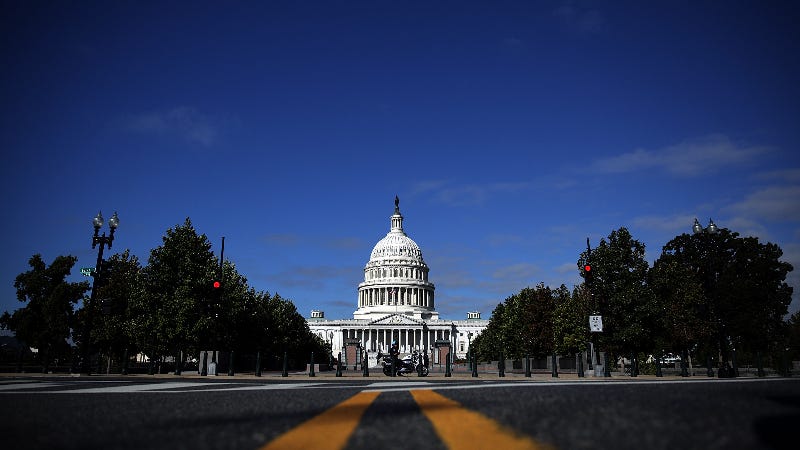Coronavirus relief and stimulus plans: Here’s everything Washington has done (and proposed) so far

In Washington, D.C., one of the city’s largest streets connects monetary policymakers at the Federal Reserve with their fiscal counterparts in Congress. It’s a telling metaphor for the shared race both teams seem to be on: buffeting the economic fallout from the coronavirus.
Officials at the Fed haven’t sat still, with the U.S. central bank slashing rates to zero in a surprise meeting March 15 and implementing 13 different emergency lending facilities to keep money flowing freely throughout the economy. The rest has been left up to Congress.
Congress has now passed three coronavirus relief bills and dropped a bazooka with its March 27 response: The Coronavirus Aid, Relief and Economic Security (CARES) Act. The package totaled more than $2 trillion, the largest fiscal care package in modern American history.
“The Federal Reserve only has so many tools in its toolbox. They are powerful, but they are not a panacea,” says Mark Hamrick, Bankrate’s senior economic analyst and Washington bureau chief. “This is why attention has been laser-focused on Congress and the Trump administration as we look for a fiscal response. In a variety of forms, these measures are intended to address the solvency of both individuals and businesses. The fear is, without such measures, the economy will experience an even more severe and prolonged contraction.”
Lawmakers want another deal but have so far struggled to agree on what the next package will look like. Broadly speaking, their goals include reinstating enhanced unemployment benefits and issuing another round of direct stimulus payments. Trump circumvented a gridlocked Congress on Aug. 8 by taking additional executive actions.
With the news cycle moving at a breakneck pace, it can be hard to wrap your head around all of the actions that have the potential to impact your wallet. Here’s a breakdown of different measures, along with where they currently stand — plus how they could help backstop your finances against an ailing economy and where they may fall short, according to experts.
1. Expanded unemployment insurance
Implemented in second relief bill, CARES Act, executive order
Congress’ most generous — and arguably most important — coronavirus aid was a supplementary unemployment insurance (UI) boost.
The CARES Act expanded unemployment insurance to cover most individuals for 39 weeks, including the typically non-eligible gig economy workers and freelancers. It also boosted individuals’ weekly checks by an extra $600, though that provision expired at the end of July.
Lawmakers have since been gridlocked over how to reinstate those extra benefits. Republicans were pushing for a $200 boost on concerns that the extra checks were deterring individuals from working. Democrats are advocating for the original benefit amount.
Trump circumvented a gridlocked Congress on Aug. 8 by taking executive action to boost unemployment benefits by $400 in the interim for certain unemployed individuals, though implementing the order has been tricky. Questions about constitutionality persist, and states already hit hard with budget restraints during the pandemic are struggling to cover the required 25 percent of the costs.
In many cases, it means delays until individuals get their checks, which might end up totalling $300 now instead of $400, based on additional Labor Department guidelines.
Those extra funds were a lifeline for the unemployed. The supplemental $600 aid made the average weekly unemployment check two times higher than what it was before the pandemic, helping Americans cover essentials such as rent and food at a time when joblessness was at its highest since the Great Depression.
Congress’ second coronavirus relief plan, the Families First Coronavirus Response Act, passed March 18, provided $1 billion to expand unemployment insurance. Half of that amount was reserved for building out staff to administer and process unemployment insurance applications, as an unprecedented uptick in applicants overwhelms the system. The other half was an emergency grant for states that experience at least a 10 percent jump in unemployment.
2. Payroll tax deferral
Implemented in executive memorandum
Another executive memorandum that Trump signed on Aug. 8 delayed payroll taxes (6.2 percent for Social Security Security and 1.45 percent for Medicare) from Sept. 1 through the rest of 2020 on employees who make less than $4,000 biweekly on a pretax basis, or about $104,000 annually.
With payroll taxes paid by firms, Trump argues this would reduce business’ fixed costs, boosting workers’ take-home pay. Businesses, however, are unsure of how to implement the order, given that the bill will still come due. Trump had long been pushing for a payroll tax cut in response to the coronavirus, but lawmakers on both sides of the aisle were hesitant to fulfill those wishes, given that it would only help employed individuals rather than the jobless Americans who really need the aid.
3. Eviction moratorium
Implemented in executive order, presidential actions
With fears growing that mass joblessness may prompt evictions or foreclosures, Trump on Sept. 1 gave the Centers for Disease Control and Prevention (CDC) direct authority to halt evictions for most renters through the rest of the year on concerns that it could spread the virus.
It comes close to a month after Trump signed an Aug. 8 executive order that gave authority to CDC Director Robert Redfield and Health and Human Services Secretary Alex Azar to “consider” whether any measures that temporarily halt evictions of tenants who don’t pay rent are “reasonably necessary” to prevent the spread of the coronavirus.
Trump also instructed Secretary of Housing and Urban Development Ben Carson to provide renter and homeowner assistance to minimize evictions and foreclosures, steps that could include helping public housing agents and affordable housing owners, landlords and other recipients of federal funds.
4. Suspend student loan payments, interest accrual postponed until September
Implemented in CARES Act, executive action
Since mid-March, federal student loans have been in a mandated forbearance period that’s waived all payments and interest through 2020.
Implementing the process at times has felt like a wild goose chase. Trump announced on March 20 that he was directing the Department of Education to waive all interest and loans, which Education Secretary Betsy DeVos obliged by. Then, Congress made that more specific in the CARES Act by specifically granting the relief to federal student loan borrowers. That provision was originally set to expire on Sept. 30, but Trump extended the period through an executive memorandum signed on Aug. 8.
This forbearance program doesn’t apply to private student loans, though some lenders and servicers may be able to work out a payment plan if you’re facing hardship because of the pandemic.
5. Sent checks of $1,200 or more to many Americans
Implemented in CARES Act
As part of the massive $2 trillion-plus relief package, lawmakers sent direct checks to many Americans in low- and middle-class income categories. Treasury Secretary Steven Mnuchin estimates that more than 80 million Americans received payments by April 22.
How much someone received was based on their annual adjustable gross income (AGI), which is earnings after top-line deductions. Individuals making up to $75,000 a year received the full $1,200 relief payment, while couples making up to $150,000 received $2,400. Both groups received an additional $500 per child under age 17.
After that, payments were phased out to individuals who make more than $75,000 annually, with the lump sum tapering off by $5 per every $100 over the threshold. An individual making $80,000 a year, for example, was in line to receive a $950 payment. Individuals who make more than $99,000 and couples who bring in $198,000 annually didn’t receive a check at all. Checks were based on income during the 2019 tax year, if they’ve already been filed. If not, they were based on a 2018 filing.
The idea behind giving Americans checks is to quickly circulate money back into the economy faster than a tax cut. It also comes with less restrictions, with Americans being able to use it however they choose. But a Bankrate survey from March found that the payments won’t be enough to cure Americans of their financial hardship. Nearly a third of those expecting a check said the cash wouldn’t sustain their financial well-being for an entire month, including 8 percent who said it won’t be enough to help at all.
6. Established a ‘Paycheck Protection Program’
Implemented in CARES Act
Through the CARES Act, Congress earmarked $349 billion worth of funds that would ultimately end up in the hands of small businesses. Known as the “Paycheck Protection Program,” the funds were administered through the Small Business Administration and deemed forgivable, so as long as firms used the cash to keep employees on their payroll and pay them for eight weeks.
The first pot of money went quickly, drying up on April 16 after around 1.7 million loans were distributed. The Senate on April 21 passed a fourth bipartisan bill totaling $484 billion, which allocated more than $300 billion toward replenishing the funds. Demand quickly waned, with the program closing officially Aug. 8 with about $130 billion in funds left unused.
Though the provisions won’t provide Americans with money directly, the funds still played an important role in preventing more people from losing their jobs and income. Some experts, however, worried businesses still facing hardship might have to let employees go after reaching the eight-week mark, while other research suggests the program was rife with challenges and fraud.
7. Allow up to $100K to be withdrawn from retirement accounts penalty-free
Implemented in CARES Act
If you’ve faced financial hardship and have a 401(k) or IRA, you can now tap into those retirement accounts, thanks to the CARES Act.
Individuals can take up to $100,000 — or 100 percent of their vested account balance if it’s less than that amount — from their retirement accounts through “hardship distributions” from now until December 31, 2020, all without the typical 10 percent early withdrawal penalty.
You’ll still need to pay income taxes on that money, but can do so over a three-year period. You can also pay back all or a portion of what you owe without it being counted against the maximum annual contribution limit.
Consumers have also been directed to provide their employer some sort of proof that they’ve faced hardship from the virus, though specific documentation isn’t required at this time, Gottfried says. Reasons could be contracting the virus or caring for a family member with the disease.
“The benefit of dipping into your retirement savings is that the person who you owe this money to is yourself,” says Edward Gottfried, a retirement expert at Betterment for Business. “It opens up some flexibility for Americans who have been lucky enough to be employed by a company that has a 401(k), to be able to use that 401k if they have an immediate hardship or need.”
Separate from relaxed emergency withdrawals, the CARES Act also suspended required minimum distributions (RMDs) from savings vehicles such as a 401(k), IRA and 403(b)s. That gives retirees’ accounts a chance to pick back up, amid some volatile and severe market swings.
8. Delayed the tax deadline to July 15 from April 15
Implemented in national emergency declaration
A move that Bill Hoagland, senior vice president at the Bipartisan Policy Center, says isn’t to be underestimated, the IRS and Treasury Department extended the 2020 tax deadline to July 15 from April 15 to help individuals who’ve felt economic woes of the coronavirus. Individuals weren’t charged any interest, fees or penalties, and the executive order included both filing and making payments.
“Quite frankly, for anyone that owes taxes, that could be the most beneficial in the short term as opposed to them getting a thousand dollars,” says Hoagland, who specializes in analyzing economic and fiscal policy at the think tank.
9. Established paid sick leave policies for individuals, families
Implemented in Families First Coronavirus Response Act
The second coronavirus relief bill updated the Family and Medical Leave Act of 1993 by creating new measures supporting individuals who need to take time off work — either to recover from an illness or to care for an ill family member.
Individuals can now take a two-week sick leave or a three-month leave to care for a child out of school or daycare. Sickness includes not just those who are infected but those who are quarantined with possible infection, according to the bill.
The new provision, however, applies only to firms with less than 500 employees, which has likely excluded a lot of people, judging from Labor Department data. Nearly half (or 48 percent) of workers in the private sector have jobs at firms with 500 or more employees. More than 1 in 10 private-industry workers (11 percent) at firms with more than 500 employees do not have access to paid sick leave, according to the Department of Labor.
Paid leave also isn’t guaranteed to emergency responders or health care providers. Firms with fewer than 50 employees can be exempted if the Department of Labor deems that the measures would “jeopardize the viability of the business.”
When it comes to pay, individuals may see their income drop as a result. Those on sick leave would be paid no more than $511 each day, while those who are caring for a family member would be paid up to $200 each day, according to the bill.
What you should do in the meantime
Many Americans were living from paycheck-to-paycheck before the outbreak, according to a Bankrate survey from May. The current environment will only exacerbate the thorny consumer finance problem.
“Between unemployment aid, direct cash assistance and loans, the idea is to help Americans keep current on their bills and keep food on their tables,” Hamrick says. “Ideally, if businesses both large and small can avoid more wide-scale layoffs, workers can avoid the worst-case scenario in terms of the economic fallout from the global pandemic.
As the U.S. economy enters uncharted territory, it’s important to place a priority on your personal finances as best as you can. Separate what you need to do into a short- and long-term scenario, Hamrick says. That includes saving for emergencies and retirement, as well as paying down debt.
For your emergency savings, consider opening a high-yield savings account, which still offers a rate that beats the market average. It’s also a good idea to stay up to date on programs at the state and federal level aimed at reducing financial hardship.
“The president has likened the current situation to a wartime footing,” Hamrick says. “At some point, we will emerge from both these health and economic crises as we have from every other challenging period in our nation’s history.”
Learn more:
- 13 steps to take if you’ve lost your job due to the coronavirus crisis
- What to do if you can’t pay your loans during the coronavirus
- When should you spend your emergency fund?
Why we ask for feedback Your feedback helps us improve our content and services. It takes less than a minute to complete.
Your responses are anonymous and will only be used for improving our website.






